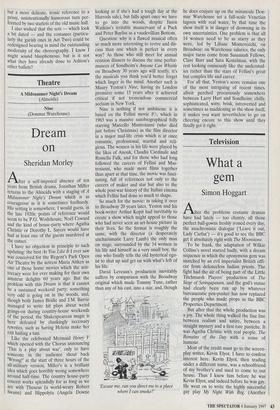Dance
Cinderella (Royal Opera House)
Creaking Kirov
Giannandrea Poesio
If you enjoy the idea of ballet being a nonsensical hotchpotch of prancing kids, animated toys, skipping mice, pretty bal- lerinas and wimpish heroes, then The Nutcracker is the work for you. Like most dance people, and I do not mean bal- letomanes, I have always been put off by its unflattering lack of dramatic depth, the silliness of its plot (derived, alas, from one of Hoffman's most beautiful and unwieldy tales) and its faulty, disjointed structure namely one act of conventional pantomime and one of mere ornamental dancing. It is difficult, therefore, to assess the Kirov's performance at the London Coliseum, because the context reflected considerably the company's skills and qualities.
Created in 1934, Vasily Vainonen's ver- sion of The Nutcracker is a straightforward revision of the old 1893 ballet which focus- es almost exclusively on technical display. Forget, then, the various 'psychological' readings formulated by some enlightened contemporary choreographers in order to make the ballet artistically and culturally more acceptable, as well as those brilliant modern desecrations by Mark Morris or Matthew Bourne.
The Kirov's Nutcracker is a celebration of the company's past which indulges in a stubborn preservation of a mothball-scent- ed tradition. It's a pity that the formulae of the old Soviet ballet — of which Vainonen was one of the most significant representa- tives — do not match late 20th-century Western aesthetics.
`Qualifications? Well, I'm on a salt-free diet.' The choreographic layout is probably one of the most horrid I have ever seen, based on a series of awkward technical solutions that clash vividly with the lyrical nuances of Tchaikovsky's score. Never before have I seen the Snowflakes charging up a slope at the back of the stage like a bunch of enthusiastic viragos on a skiing holiday (why should they go up, anyway?) or a Waltz of the Flowers where the women in the corps de ballet are lifted in the fashion of circus acrobats, thus showing all the physical effort required.
The stubborn preservation of anachro- nistic components mentioned above is also evident in the ghastly designs. Apart from the overwhelming use of pink and blue as if the sugary nature of the work needed to be stressed further — there is a profu- sion of stylistically challenged costumes, ill- fitting wigs and a great deal of heavy makeup.
The dancing was unimpressive, too. It would appear that the company's recent financial crisis has affected the fine quality of the Kirov style, particularly as far as the use of the upper body — for which Russian dancers were once renowned — is con- cerned. The overall impression was of a routine performance where no one, includ- ing principal dancers such as Altynay Asyl- muratoia, was remotely interested in putting some art into the part. Yet, as I have said before, it is difficult to ascertain how much this depended on the uninspir- ing version of the work.
Unlike Vainonen's Nutcracker, Ashton's Cinderella boasts a unique choreographic translation of the score. The angularity of the movements, used throughout the ballet, responds beautifully to the often quirky melodic and rhythmical shadings to be found in Prokofiev's complex musical palette. Although the Royal Ballet danced beautifully — Darcey Bussell, Jonathan Cope, Cristina McDermott and Sarah Wildor were technically and stylistically stunning — on the opening night the ballet lacked both that magic sparkle and that refined grandeur it used to have.
I found that the actions of the two Ugly Sisters, one of the ballet's strongest ele- ments, were not particularly exciting and too over the top. It is true that in devising the two roles Ashton intended to pay trib- ute to the great tradition of the English pantomime. Still, the choreographer's sense of comedy was never meant as a cheap, predictable series of jests. Subtle references and innuendos — two distinc- tive traits of Ashton's creative genius seem to have been overlooked or misun- derstood. For example, the dance with the fan performed by the bossy sister in the second act was an affectionate parody of the solo Rondino as danced and choreo- graphed by Anna Pavlova — one of the choreographer's muses — and it should be danced as such. Similarly, the 'oranges duet' in the same act should not be the raunchy cavalcade across the stage I saw, but a more delicate, ironic reference to a prissy, unintentionally humorous turn per- formed by two starlets of the old music hall. I also wished that the sets — which look a bit dated — and the costumes (particu- larly the garish ones in Act Two) could be redesigned bearing in mind the outstanding modernity of the choreography. I know I might sound blasphemous, but is it not what they have already done to Ashton's other ballets?



























































 Previous page
Previous page